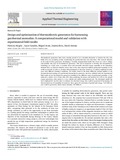Mostrar el registro sencillo del ítem
Design and optimization of thermoelectric generators for harnessing geothermal anomalies: a computational model and validation with experimental field results
| dc.creator | Alegría Cía, Patricia | es_ES |
| dc.creator | Catalán Ros, Leyre | es_ES |
| dc.creator | Araiz Vega, Miguel | es_ES |
| dc.creator | Erro Iturralde, Irantzu | es_ES |
| dc.creator | Astrain Ulibarrena, David | es_ES |
| dc.date.accessioned | 2023-10-31T17:57:06Z | |
| dc.date.available | 2023-10-31T17:57:06Z | |
| dc.date.issued | 2024 | |
| dc.identifier.citation | Alegría, P., Catalán, L., Araiz, M., Erro, I., Astrain, D. (2024) Design and optimization of thermoelectric generators for harnessing geothermal anomalies: a computational model and validation with experimental field results. Applied Thermal Engineering, 1-14. https://doi.org/10.1016/j.applthermaleng.2023.121364. | en |
| dc.identifier.issn | 1359-4311 | |
| dc.identifier.uri | https://hdl.handle.net/2454/46694 | |
| dc.description.abstract | Thermoelectric generators have been recently proved to be a feasible alternative to harness hot dry rock fields with very promising results transforming the geothermal heat into electricity. This research deepens in the study of these generators, developing a versatile computational model that serves as a tool to design and optimize this type of thermoelectric generators. This tool is important to develop this thermoelectric technology on a large scale, to produce clean and renewable electrical energy especially in the Timanfaya National Park, in Lanzarote (Spain), where some of the most important shallow geothermal anomalies in the world are located, in order to promote self-consumption in this zone. However, it could be employed in other areas with different boundary conditions. The model, based in the finite difference method applied to the thermal-electrical analogy of a geothermal thermoelectric generator, has been validated with the experimental field results of two thermoelectric generators installed in two different zones of geothermal anomalies. It has achieved a relative error of less than 10% when predicting the power and between 0.5–1.6% in the annual energy generation, what makes it a very reliable and useful computational tool. The developed model has been employed for the first time to estimate the electrical energy that could be generated if harnessing the characterized area of anomalies in Lanzarote. Here, given the continuity of geothermal energy, 7.24 GWh per year could be generated, which means annually 1.03 MWh/m2. | en |
| dc.description.sponsorship | We would like to acknowledge the support of the Spanish State Research Agency and FEDER-UE, Spain under the grants TED2021-129359B-I00 and PID2021-124014OB-I00. We would also like to acknowledge the support of the Official School of Industrial Engineers of Navarre, Spain with the scholarship Fuentes Dutor. Open access funding provided by the Public University of Navarre, Spain . | en |
| dc.format.mimetype | application/pdf | en |
| dc.language.iso | eng | en |
| dc.publisher | Elsevier | en |
| dc.relation.ispartof | Applied Thermal Engineering 236, (2024), 121364 | en |
| dc.rights | © 2023 The Author(s). This is an open access article under the CC BY-NC-ND license. | en |
| dc.rights.uri | http://creativecommons.org/licenses/by-nc-nd/4.0/ | |
| dc.subject | Anomaly | en |
| dc.subject | Computational model | en |
| dc.subject | Finite differences | en |
| dc.subject | Geothermal energy | en |
| dc.subject | Thermoelectric generator | en |
| dc.title | Design and optimization of thermoelectric generators for harnessing geothermal anomalies: a computational model and validation with experimental field results | en |
| dc.type | Artículo / Artikulua | es |
| dc.type | info:eu-repo/semantics/article | en |
| dc.date.updated | 2023-10-31T17:39:38Z | |
| dc.contributor.department | Institute of Smart Cities - ISC | en |
| dc.rights.accessRights | Acceso abierto / Sarbide irekia | es |
| dc.rights.accessRights | info:eu-repo/semantics/openAccess | en |
| dc.identifier.doi | 10.1016/j.applthermaleng.2023.121364 | |
| dc.relation.projectID | info:eu-repo/grantAgreement/AEI//TED2021-129359B-I00 | en |
| dc.relation.projectID | info:eu-repo/grantAgreement/AEI//PID2021-124014OB-I00 | en |
| dc.relation.publisherversion | https://doi.org/10.1016/j.applthermaleng.2023.121364 | |
| dc.type.version | Versión publicada / Argitaratu den bertsioa | es |
| dc.type.version | info:eu-repo/semantics/publishedVersion | en |
| dc.contributor.funder | Universidad Pública de Navarra / Nafarroako Unibertsitate Publikoa | es |



